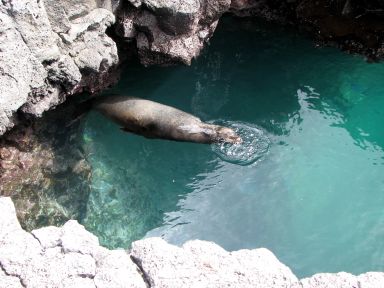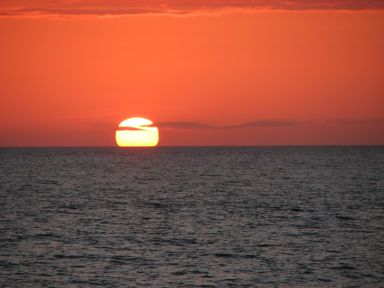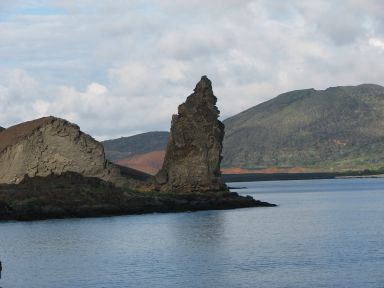
2011-04-27: Blue Footed Booby
Our visits to the islands rewarded us with up-close and personal viewings of the many animals who call the Galapagos home. I could describe them and tell you about them but I really don't want to bore you so sit back and enjoy the pictures and short descriptions. I will say seeing the blue footed booby and the iguanas up close were a highlight.

2011-04-27: Panga
We were able to reach the islands by panga (dingy) where we had either wet or dry landings.

2011-04-27: Land Iguana
The Galapagos Land Iguana resembles the mythical creatures of the past-dragons with long tails, clawed feet and spiny crests. Land Iguanas have a spiky dorsal crest which runs along the neck and back. They are heavily bodied with thick back legs and smaller front legs.

2011-04-27: Sally Lightfoot
The Sally Lightfoot Crab is also known as the 'Red Rock Crab'.

2011-04-27: Pelican
The Brown Pelican is found throughout the Galapagos Islands, skimming over water, plunge-diving and resting in mangrove trees. They measure around 41 inches in length and have a wingspan of 90 inches.

2011-04-27: Lava Heron
The Lava Heron, also known as the Galapagos Heron, is a species of heron endemic to the Galapagos Islands. The adult is slate-grey, which helps it blend in with the hardened lava. Its back feathers typically have a silvery sheen and it has a short crest on its head. When breeding, the heron has a black beak and bright orange legs, but they fade to grey after the breeding season. The Lava Heron stalks small crabs and fish slowly before quickly spearing and eating them. These birds have no fear of humans. Lava Herons are small (35 centimetres), grey, dark on wings and back, and orange legs.

2011-04-27: Flamingo
Galapagos Flamingos are gregarious, wading birds that belong to a family of large, brilliantly colored aquatic birds whose habitats are alkaline or saline lakes. Long legs and a long, curved neck are characteristic of all flamingo species.

2011-04-27: Vermillion Flycatcher
The Vermillion Flycatcher has a short, wide beak, sometimes with hooked tips which are good for catching and holding onto flying insects. They are small birds measure 5-6 inches.

2011-04-27: Iguana Nest
We were lucky enough to see this land iguana nest as well as a marine turtle nest on our adventures.

2011-04-28: Lava Beach
The lava sand made for a few problems when it got into your tevas and then rubbed on your feet.

2011-04-28: Lizard
We saw many species of lizards but this one was unique.

2011-04-28: Galapagos Hawk
The Galapagos Hawk is a large, dark colored bird with broad wings and a broad tail. It's an active predator which feeds on small invertebrates such as small lizards, snakes and rodents. Galapagos Hawks can grow to be about 2-feet long with a wingspan of 4-feet.

2011-04-28: Sea Lion
There are two kinds of sea lions in the islands: the California sea lion and the Galapagos fur seal.

2011-04-28: Marine Iguana
The Marine Iguana evolved from a mainland ancestor who arrived on the islands millions of years ago. Your first thoughts would probably be of a primitive dinosaur with its dorsal crest and primitive features. This particular species of lizard is the only sea-going lizard in the world. However, like all reptiles (except some sea snakes), it has to return the land to breed.

2011-04-28: Pahoehoe
Some of the islands are covered with rope lava or pahoehoe.

2011-04-28: Sabina
Our naturalist Sabina was very thorough in guiding us on the islands, identifying wildlife and filling us in on facts and history.

2011-04-28: More Iguanas
Needless to say, we loved the iguanas!

2011-04-28: Sally Lightfoot
A prancing Sally Lightfoot.

2011-04-29: Marine Iguana
A smiling marine iguana.

2011-04-29: Lava Cactus
Growing in lava fields as their name suggests, these small cactus grow in clumps measuring up to 23 inches in height. New growth on the cacti is yellow but as it matures, the color fades becoming paler and eventually becomes a gray or black color with age.

2011-04-29: Al And Friends
We were amazed at how close we could get to the wildlife without them scurrying off.

2011-04-29: Flightless Cormorant
The Flightless Cormorant is unique in that it is the only cormorant that has lost the ability to fly.

2011-04-29: Mama and Child
Nursing sea lion

2011-04-29: Blue Footed Booby
The Blue-footed Booby plunges head first into the ocean, with its wings partly folded, to catch fish. It even catches flying fish when they are still in the air. It can also dive for fish while it is in a swimming position. Watching them go head first into the water at top speed made us wonder how often they get hurt.

2011-04-29: Great Blue Heron
It was amazing to us that the Great Blue Herons here in the Galapagos were not skittish like their relatives in the states. We could get quite close to them to take their picture and they didn't even give us a second glance!

2011-04-29: Galapagos Penguin
The Galapagos Penguin is the only penguin to live north of the equator as well as the only species totally restricted to the tropics. Galapagos Penguins have a thin white band that runs under their chin. They have a black upside down horseshoe shape around their belly. This is what mostly distinguishes them from other penguins.

2011-04-29: Pelican
It was fun seeing the pelicans up close and personal.

2011-04-29: Sunset
We did have some beautiful sunsets.

2011-04-29: Sunset
The clouds in front of the sun created an extremely interesting photo.

2011-04-29: Porpoise
It was fun watching the porpoise jump behind the boat.

2011-04-30: Pinnacle Rock
On the island of Bartolome we got to view Pinnacle Rock, an icon of the Galapagos.

2011-04-30: Mangrove
We took a panga ride to explore a complex system of small sea ponds that were surrounded by black and red mangroves. Here we got to see...

2011-04-30: Sea Turtles
...sea turtles...

2011-04-30: Shark
...and shark!

2011-05-01: Rainbow
As we entered the Charles Darwin Research Station we saw this beautiful rainbow.

2011-05-01: Giant Tortoise
Galapagos Giant Tortoises keep growing until they are about 40 - 50 years old and can reach a weight of 500 pounds. It can grow to be 5 feet tall which makes them the largest tortoises in the world. In general, they are the longest living of all vertebrates.

2011-05-01: Lonesome George
Lonesome George is the last known individual of the Pinta Island Tortoise which is one of the 8-15 subspecies of the Galapagos tortoise. He has been labeled the rarest creature in the world and was relocated here for his own good because his native island's vegetation had been devasted by introduced feral goats. George was penned with two females of a different subspecies, but although eggs have been produced, none has hatched.